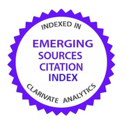The commission for early repayment of mortgage loans in Spain. A proposal for improvement
DOI:
https://doi.org/10.26360/2024_02Keywords:
early amortization, early repayment, loans, commission for early repayment, compensation for withdrawal, compensation for interest riskAbstract
The objective of this work is to analyze the evolution of the regulations regarding the commission for early repayment of mortgage loans in Spain and to propose an improvement proposal that benefits clients more than the current regulations. To do this, the effects of this regulatory evolution on a case are analyzed, distinguishing different interest rate scenarios, with different regulations and taking into account the proposed proposal. The results show that the regulations that affect the application of commissions or cancellations for early repayment of loans have been raising the level of protection of clients of banking services and the balance between the parties (lender and borrower) over time. For this reason, with the current regulations (Law 5/2019) lower commissions are applied than with previous regulations since commissions for early cancellation have been eliminated and limits have been established on compensation for interest risk that represent a lower cost for borrowers when they repay their loans early, but without producing adverse scenarios for lenders due to the evolution of interest rates. Furthermore, the proposed proposal continues along this line of benefit to the client and even improves it substantially because the components of the commission would be based on financial valuation criteria and the financial loss for the entity would be measured in a more reasonable way.
Downloads
References
Agarwal, S., Amromin, G., Chomsisengphet, S., Landvoigt, T., Piskorski, T., Seru, A. y Yao, V. (2023). Mortgage refinancing, consumer spending, and competition: Evidence from the home affordable refinance program. The Review of Economic Studies, 90(2), 499-537.
Assungấo, J. J., Benmelech, E. y Silva, F. S. (2014). Repossession and the Democratization of Credit. The Review of Financial Studies, 27(9), 2661-2689. https://doi.org/10.1093/rfs/hht080
Banco de España (2023a). Boletín Estadístico, mayo, 91-319.
Banco de España (2023b). Tipos de interés. Boletín Estadístico, septiembre. Obtenido de: https://www.bde.es/webbe/es/estadisticas/otras-clasificaciones/publicaciones/boletin-estadistico/capitulo-19.html. Fecha de acceso: 16 de octubre de 2023.
Beltratti, A., Benetton, M. y Gavazza, A. (2017). The role of prepayment penalties in mortgage loans. Journal of Banking and Finance, 82, 165-179. http://dx.doi.org/10.1016/j.jbankfin.2017.06.004
Bond, P., Musto, D. K. y Yilmaz, B. (2009). Predatory mortgage lending. Journal of Financial Economics, 94(3), 412-427. https://doi.org/10.1016/j.jfineco.2008.09.011
Bover, O., Crespo, L. y García-Uribe, S. (2022). El endeudamiento de los hogares en la encuesta financiera de las familias y en la central de información de riesgos: un análisis comparativo. Documentos Ocasionales, 2205, Banco de España.
Calza, A., Monacelli, T. y Stracca, L. (2013). Housing Finance and Monetary Policy. Journal of the European Economic Association, 11(s1), 101-122. https://doi.org/10.1111/j.1542-4774.2012.01095.x
Campbell, J. Y., Ramadorai, T. y Ranish, B. (2015). The Impact of Regulation on Mortgage Risk: Evidence from India. American Economic Journal: Economic Policy, 7/4), 71-102. https://doi.org/10.1257/pol.20130220
Deng, Y., Quigley, J. M. y Order, R. (2000). Mortgage Terminations, Heterogeneity and the Exercise of Mortgage Options. Econometrica, 68(2), 275-307. https://doi.org/10.1111/1468-0262.00110
Dunn, K. B. y Spatt, C. S. (1985). An analysis of mortgage contracting: prepayment penalties and the due-on-sale clause. Journal of Finance, 40(1), 293-308. https://doi.org/10.1111/j.1540-6261.1985.tb04950.x
Goldstein, D. y Son, S. S. (2003). Why prepayment penalties are abusive in subprime home loans. Policy Paper, 4. Center for Responsible Lending.
INE (2023). Hipotecas. Porcentaje de hipotecas constituidas según tipo de interés. Obtenido de: https://www.ine.es/jaxiT3/Datos.htm?t=24459. Fecha de acceso: 17 de octubre de 2023.
Keys, B. J., Piskorski, T., Seru, A. y Yao, V. (2014). Mortgage rates, household balance sheets, and the real economy (No. w20561). National Bureau of Economic Research.
Ley 2/1994, de 30 de marzo, sobre subrogación y modificación de préstamos hipotecarios (BOE núm. 80, de 4 de abril de 1994).
Ley 41/2007, de 7 de diciembre, por la que se modifica la Ley 2/1981, de 25 de marzo, de Regulación del Mercado Hipotecario y otras normas del sistema hipotecario y financiero, de regulación de las hipotecas inversas y el seguro de dependencia y por la que se establece determinada norma tributaria (BOE núm. 294, de 8 de diciembre de 2007).
Ley 5/2019, de 15 de marzo, reguladora de los contratos de crédito inmobiliario (BOE núm. 65, de 16 de marzo de 2019).
Maudos, J. (2022). Cambios en la estructura de ingresos de la banca española. Cuadernos de Información Económica, 289, 23-30.
Mayer, C., Pence, K. y Sherlund, S. M. (2009). The Rise in Mortgage Defaults. Journal of Economic Perspectives, 21(1), 27-50. https://doi.org/10.1257/jep.23.1.27
Mayer, C., Piskorski, T. y Tchistyi, A. (2013). The inefficiency of refinancing: Why prepayment penalties are good for risky borrowers. Journal of Financial Economics, 107(3), 694-714. https://doi.org/10.1016/j.jfineco.2012.10.003
Mian, A., Rao, K. y Sufi, A. (2013). Household balance sheets, consumption, and the economic slump. The Quarterly Journal of Economics, 128(4), 1687-1726. https://doi.org/10.1093/qje/qjt020
Orden ECE/482/2019, de 26 de abril, por la que se modifican la Orden EHA/1718/2010, de 11 de junio, de regulación y control de la publicidad de los servicios y productos bancarios, y la Orden EHA/2899/2011, de 28 de octubre, de transparencia y protección del cliente de servicios bancarios (BOE núm. 102, de 29 de abril de 2019).
Real Decreto-ley 19/2022, de 22 de noviembre, por el que se establece un Código de Buenas Prácticas para aliviar la subida de los tipos de interés en préstamos hipotecarios sobre vivienda habitual, se modifica el Real Decreto-ley 6/2012, de 9 de marzo, de medidas urgentes de protección de deudores hipotecarios sin recursos, y se adoptan otras medidas estructurales para la mejora del mercado de préstamos hipotecarios (BOE núm. 281, de 23 de noviembre de 2022).
Rose, M. J. (2013). Geographic variation in subprime loan features, foreclosures, and prepayments. Review of Economics and Statistics, 95(2), 563-590. https://doi.org/10.1162/REST_a_00256
Steinbuks, J. (2015). Effects of prepayment regulations on termination of subprime mortgages. Journal of Banking & Finance, 59, 445-456. https://doi.org/10.1016/j.jbankfin.2015.07.012
Downloads
Published
Versions
- 2024-12-12 (2)
- 2024-07-31 (1)
How to Cite
Issue
Section
License
Copyright (c) 2024 Carmen González Velasco, Marcos González Fernández

This work is licensed under a Creative Commons Attribution-NonCommercial-NoDerivatives 4.0 International License.


















